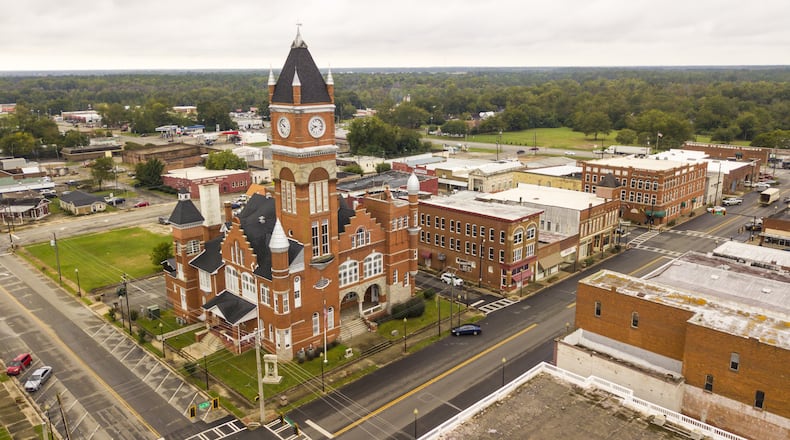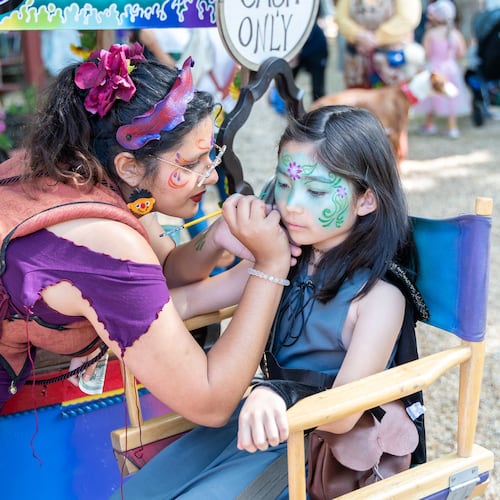A gay nightclub, a “hanging jail” and a one-room schoolhouse are among the structures and sites named in the Georgia Trust for Historic Preservation’s latest list of 10 Places in Peril.
The nonprofit’s annual list draws attention to unique and historic properties and sites around the state that are in danger of disappearing.
This is the 16th list published by the Trust, which has successfully campaigned to save some structures — and has failed to save others.
The Tudor-style mansion Glenridge Hall in Sandy Springs was leveled several years ago, despite the Trust’s efforts. But Fountain Hall on the Morris Brown campus, which was listed last year, is on the mend. “It looks like it is going to be a success,” said Mark C. McDonald, president and CEO of the Trust.
Here are the structures and site on the 2021 list.
Credit: Georgia Trust for Historic Preservation
Credit: Georgia Trust for Historic Preservation
Ashby Street Theatre
Opened in 1934, the Ashby Street Theatre was one of Atlanta’s first movie theaters built to serve the African American community.
During the Jim Crow era, Black patrons were welcomed without having to tolerate segregated entrances and facilities.
The original marquee survives behind plywood boards, but the structure has been empty for several years, and, writes the Trust, “the interior suffers from water damage.”
Credit: Georgia Trust for Historic Preservation
Credit: Georgia Trust for Historic Preservation
Atlanta Eagle and Kodak Buildings
Constructed as private residences in 1898 and 1905, both houses were converted to commercial structures in the 1940s, as Ponce de Leon became a thriving center.
The Kodak building (at one time a camera shop) and the Eagle club (a gay nightclub) fell into disrepair; the Kodak building closed years ago, and the Eagle announced plans to close soon. But the area is surging now, providing an incentive to demolish the structures and develop the land. “This is one of our biggest challenges on our list,” said McDonald.
UPDATE: Atlanta moves to preserve Ponce’s iconic Kodak building as historic landmark
Credit: Georgia Trust for Historic Preservation
Credit: Georgia Trust for Historic Preservation
Blackshear City Jail
Constructed in 1894 in the southeast Georgia town of Blackshear, the jail was built with a tower containing its own interior gallows. Called a “hanging jail,” the gallows were apparently never put to use.
The jail could be a focus for what McDonald calls “heritage tourism,” but it must be stabilized first.
Cherry Grove Schoolhouse
In Washington, Georgia, this one-room, wood-frame building was constructed in 1910 on the grounds of the Cherry Grove Baptist Church. It is one of the few remaining “pre-Rosenwald” schools built for African Amerian students.
Cohutta African American Civic District
In Cohutta, near Dalton, which counted 661 residents during the 2010 census, there are limited resources for historic preservation. The three deteriorating properties in this civic district—including a church, a chapel and a school — are owned by the city, which recognizes the value of preservation, said McDonald.
“They are wise enough to know that they need some charming resources in their town to draw development.”
Downtown Toomsboro
Toomsboro, in Wilkinson County, south of Milledgeville, is a “whistlestop” town of 471 citizens (as measured by the 2010 census) where most of the tiny commercial district is empty and for sale.
“There are a good dozen buildings there that are abandoned, and they are all in fairly decent shape," said McDonald. "I was amazed at how good they look.”
A film production company could acquire a backlot in one purchase, McDonald suggested, but the Toomsboro structures need TLC.
Kiah House Museum
One of the first museums in Savannah founded by African Americans, the house has been empty and deteriorating since 2001. Probate challenges have stymied efforts to rehabilitate the building, though the Trust writes that there is “strong community support for the preservation and recognition of this resource.”
Credit: Georgia Trust for Historic Preservation
Credit: Georgia Trust for Historic Preservation
Old Monticello United Methodist Church
Monticello, named after Thomas Jefferson’s estate, is 56 miles southeast of Atlanta and the site of one of Georgia’s notorious lynchings.
Part of Monticello’s historic district, the 1895 Old Monticello Methodist Church, is also on the National Register of Historic Places but has been empty since the 1990s. It is owned by a “defunct” corporation, according to the Trust, which limits local efforts to save the structure.
Terrell County Courthouse
The 1892 courthouse in Dawson, between Columbus and Albany, is one of the tallest in Georgia. It was fully renovated in 2009, but Hurricane Michael damaged the roof and exterior in 2018.
After the hurricane, the court and county offices moved off-site and the building remains unoccupied. “It’s habitable, but water damage and other things make it currently not desirable,” said McDonald. “We’d love to see (the county administration) come back in.”
Vineville Avenue Corridor
Large, late‐19th century and early‐20th century homes line this thoroughfare in a historic section of Macon, but most are empty and some are being rezoned for commercial use.
A local preservation group would like to maintain the residential “fabric” of the neighborhood, and they have carried their case to planning and zoning officials, but commercial interests are pushing against these efforts.
“Economic forces are the hardest forces to compete against,” said McDonald, “but it’s an important battle to fight.”
About the Author
The Latest
Featured







